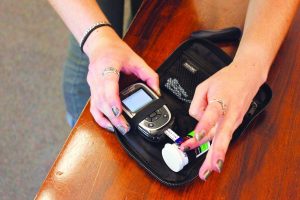During track practice one day in March, junior Olivia Sinclair blacked out for no apparent reason.
“I had been noticing that I had been getting weaker and weaker and worse all throughout the season, and then I had a hard day and we were running 800s around the track, and I just collapsed in the middle of the track,” Sinclair said. “I just passed out. My coach ran over to me and then I couldn’t breathe afterwards. My mom picked me up and she rushed me to the hospital.”
Upon arriving at the hospital and undergoing blood tests, Sinclair was diagnosed with type 1 diabetes, a chronic disease in which the pancreas stops producing insulin, a hormone needed for cells to absorb glucose and produce energy.

Junior Nadav Raman was also diagnosed with type 1 diabetes the summer before eighth grade when he noticed something was wrong with his health.
“I started waking up at night at least two or three times to go pee during the night and I noticed I wasn’t feeling good,” Raman said. “I was dropping weight. Much later, when I wasn’t feeling good, I started barfing and then I knew something was wrong. Right before I almost passed out at my house, my parents took me to Marin General Hospital.”
Both students have had to adjust to pricking their fingers to check their blood sugar levels and injecting themselves with insulin. They must make sure their blood sugar is in the healthy range every four hours, or whenever they eat, and they have to inject insulin shots to balance out the carbs they consume, a process Sinclair called a “balancing game.”
“I need to test my blood sugars, my levels, to see if it’s too high or too low, which both can be dangerous,” Raman said. “Low

blood sugars can be immediately dangerous. Then I have to do injections of insulin, which is a hormone my body can’t produce to break down sugars. So, whenever I need to eat or if I don’t have enough sugar in my body, I’ll drink a juice or eat food to make it go higher up.”
When diabetics consume too many carbs, their blood sugar shoots up, and when they inject insulin, their blood sugar drops down. According to Sinclair, the normal blood sugar range is 90 to 130 milligrams per deciliter.
“If I was higher than that, or ridiculously high, like the 300s, then I would start feeling agitated, like a zombie, just really tired and having a bad day,” Sinclair said. “It’s not fun. That happens often. It’s really hard to get in the range. If I’m low, then I’ll usually act like I’m drunk. You just act really weird and do stupid things.”
Raman said he can immediately feel when his blood sugar levels are off.
“When it’s too low, you start feeling shaky and you can pass out if you don’t get a hold of juice or food in enough time,” Raman said. “That can be really dangerous. High blood sugars over the course of time can be really dangerous because you can get kidney problems and tons of other things, but mostly you start feeling sweaty and uncomfortable when it’s high.”
Sinclair said she struggles with keeping her blood sugar in the normal range because it often gets too high.
“I usually wake up a little low, like 70, so it’s not that low, but I do have a problem with getting high often,” Sinclair said. “It just makes you really unhappy.”
Sinclair and Raman are both athletes: Sinclair runs track and cross country, and Raman plays on the JV football team. Both said that their disease does not usually interfere with their athletics because they properly take care of themselves.
“It’s actually good that I run and burn carbs because it prevents higher blood sugars and it’s easier to control,” Sinclair said. “The only danger is if [my blood sugar] is really low when I start running, but I always check it before I run.”
Although the actual shots and blood sugar checks only take about thirty minutes a day, Sinclair said she is constantly thinking about her diabetes.
“It’s always on your mind because the scary part about diabetes is that if you mess up, or if you do too much insulin, or you go to bed low, there’s a chance that in the morning, you might not wake up because you might have taken too much and you might have passed out,” Sinclair said. “It’s just something that you always have to worry about. When I’m supposed to be doing schoolwork, I could be writing something and I’ll just start spacing out and start thinking about it, like, ‘Oh, I need to prick myself.’”
Both Sinclair and Raman said that managing their disease has just become habitual to them and they generally do not find that it interferes with their social lives.
“Right as I get up, when I go to the bathroom to brush my teeth and stuff, I have my toothbrush and blood glucose meter right next to it,” Raman said. “So you check your blood sugar, and as you go to the kitchen to get food, you do a shot, and that’s pretty much it. There’s school, there’s working out, and then there’s my diabetes management.”
















